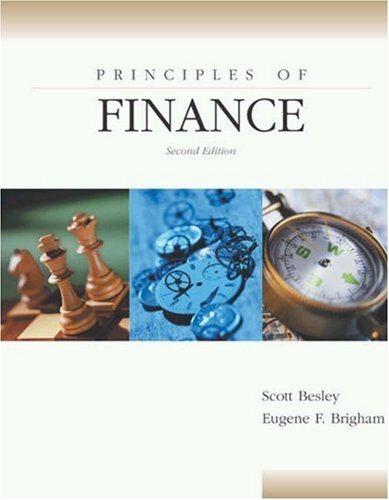Question
please help how do I answer?? Internal rate of return (IRR) The discount rate that makes the NPV of an investment zero. To illustrate the
please help how do I answer??
Internal rate of return (IRR)
The discount rate that makes the NPV of an investment zero.
To illustrate the idea behind the IRR, consider a project that costs $100 today and pays $110 in one year. Suppose you were asked, What is the return on this investment? What would you say? It seems both natural and obvious to say that the return is 10 percent page 292because, for every dollar we put in, we get $1.10 back. In fact, as we will see in a moment, 10 percent is the internal rate of return, or IRR, on this investment.
Is this project with its 10 percent IRR a good investment? Once again, it would seem apparent that this is a good investment only if our required return is less than 10 percent. This intuition is also correct and illustrates the IRR rule:
Based on the IRR rule, an investment is acceptable if the IRR exceeds the required return. It should be rejected otherwise.
Imagine that we want to calculate the NPV for our simple investment. At a discount rate of R, the NPV is:
Now, suppose we dont know the discount rate. This presents a problem, but we can still ask how high the discount rate would have to be before this project would be deemed unacceptable. We know that we are indifferent between taking and not taking this investment when its NPV is just equal to zero. In other words, this investment is economically a break-even proposition when the NPV is zero because value is neither created nor destroyed. To find the break-even discount rate, we set NPV equal to zero and solve for R:
This 10 percent is what we already have called the return on this investment. What we have now illustrated is that the internal rate of return on an investment (or just return for short) is the discount rate that makes the NPV equal to zero. This is an important observation, so it bears repeating:
The IRR on an investment is the required return that results in a zero NPV when it is used as the discount rate.
The fact that the IRR is the discount rate that makes the NPV equal to zero is important because it tells us how to calculate the returns on more complicated investments. As we have seen, finding the IRR turns out to be relatively easy for a single-period investment. Suppose you were now looking at an investment with the cash flows shown in Figure 9.4. As illustrated, this investment costs $100 and has a cash flow of $60 per year for two years, so its only slightly more complicated than our single-period example. If you were asked for the return on this investment, what would you say? There doesnt seem to be any obvious answer (at least not to us). Based on what we now know, we can set the NPV equal to zero and solve for the discount rate:
FIGURE 9.4
Project Cash Flows
Unfortunately, the only way to find the IRR in general is by trial and error, either by hand or by calculator. This is precisely the same problem that came up in Chapter 5, when we found the unknown rate for an annuity, and in Chapter 7, when we found the yield to maturity on a bond. In fact, we now see that in both of those cases, we were finding an IRR.
In this particular case, the cash flows form a two-period, $60 annuity. To find the unknown rate, we can try some different rates until we get the answer. If we were to start with a 0 percent rate, the NPV would obviously be $120 100 = $20. At a 10 percent discount rate, we would have:
NPV = - $100 + $60 / 1.1 + $60 / 1.12 = $4.13
Now, were getting close. We can summarize these and some other possibilities as shown in Table 9.5. From our calculations, the NPV appears to be zero with a discount rate between 10 percent and 15 percent, so the IRR is somewhere in that range. With a little more effort, we can find that the IRR is about 13.1 percent.6 So, if our required return were less than 13.1 percent, we would take this investment. If our required return exceeded 13.1 percent, we would reject it.
IRR is a great way to determine what projects to undertake and which one not to. The last paragraph highlights this. Here is something else to consider; if your required rate of return is too high that too many projects are being rejected, is your required rate of return too high and why? Maybe your cost of capital is too high and what can be done to lower that. This is not to suggest you should look for projects with low required rates of return as thin profit margins can quickly become negative rates of return with one bad decision. I mention it to suggest looking for diamonds in the rough can be hard to find and if too much time goes by without a project, future money raises will be a challenge.
Step by Step Solution
There are 3 Steps involved in it
Step: 1

Get Instant Access to Expert-Tailored Solutions
See step-by-step solutions with expert insights and AI powered tools for academic success
Step: 2

Step: 3

Ace Your Homework with AI
Get the answers you need in no time with our AI-driven, step-by-step assistance
Get Started


